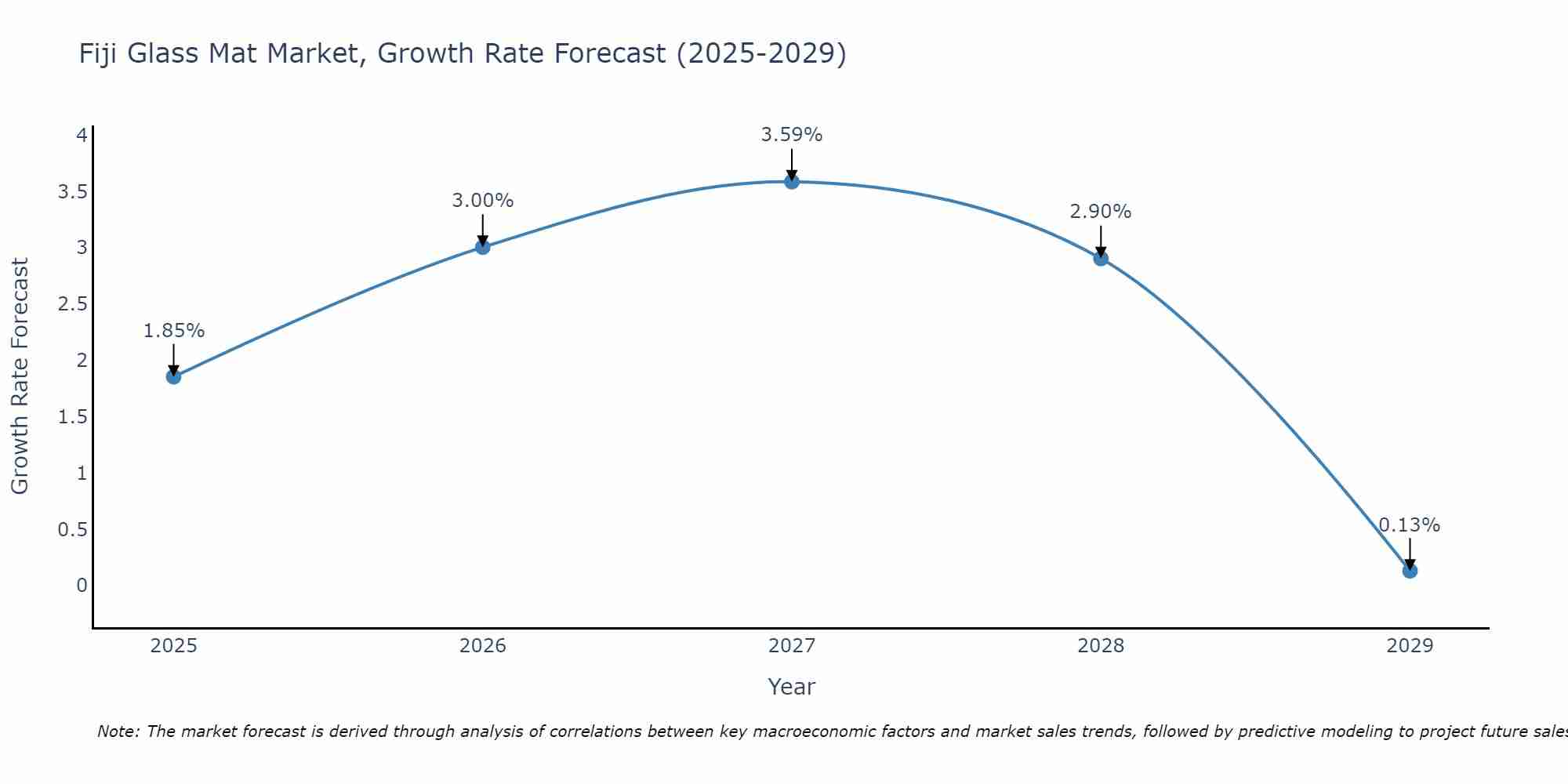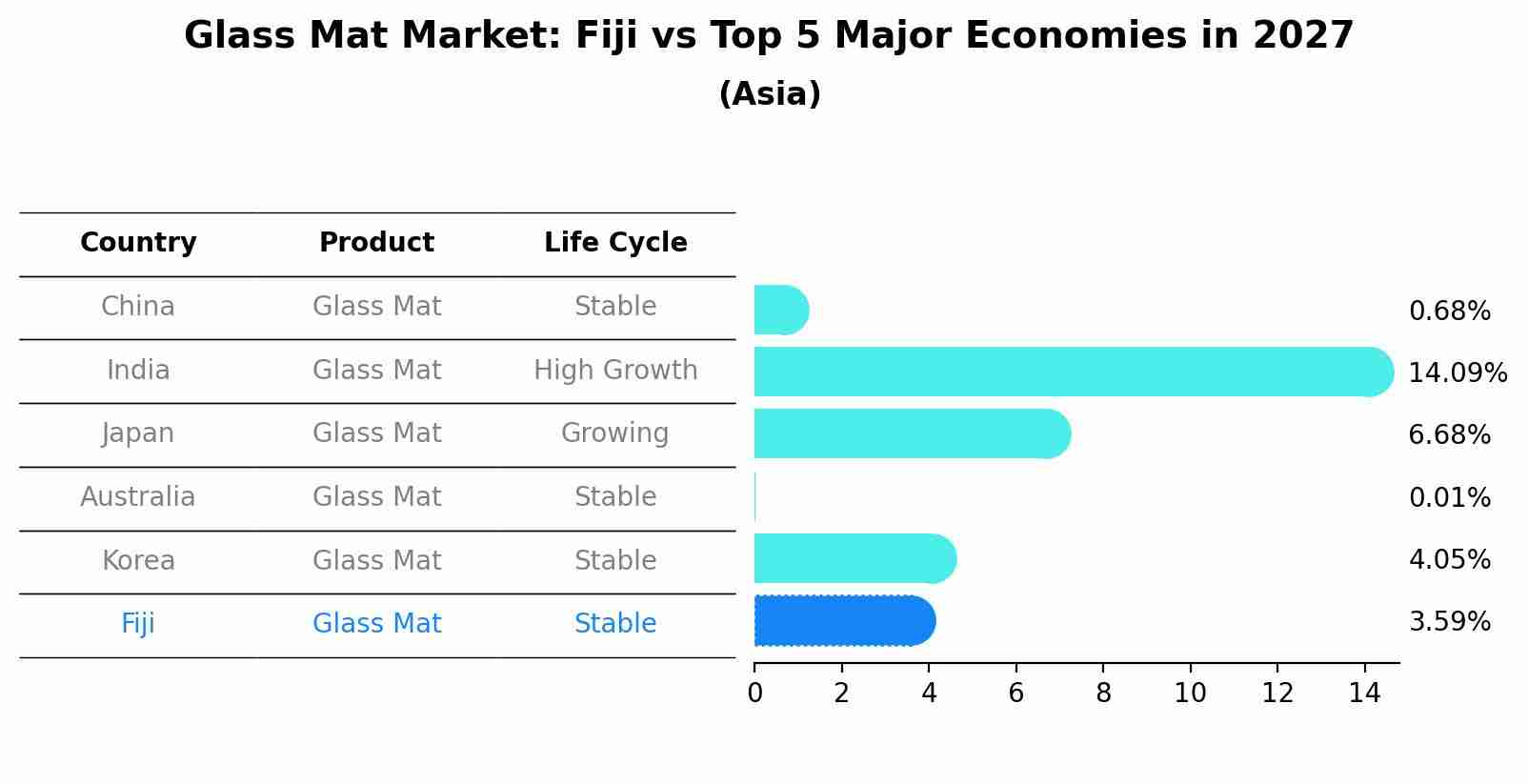Fiji Glass Mat Market (2025-2031) | Forecast, Segmentation, Companies, Share, Outlook, Value, Growth, Trends, Size, Industry, Analysis & Revenue
| Product Code: ETC4913453 | Publication Date: Nov 2023 | Updated Date: Apr 2025 | Product Type: Market Research Report | |
| Publisher: 6Wresearch | Author: Sachin Kumar Rai | No. of Pages: 60 | No. of Figures: 30 | No. of Tables: 5 |
Fiji Glass Mat Market Size Growth Rate
The Fiji Glass Mat Market is projected to witness mixed growth rate patterns during 2025 to 2029. Growth accelerates to 3.59% in 2027, following an initial rate of 1.85%, before easing to 0.13% at the end of the period.

Glass Mat Market: Fiji vs Top 5 Major Economies in 2027 (Asia)
By 2027, the Glass Mat market in Fiji is anticipated to reach a growth rate of 3.59%, as part of an increasingly competitive Asia region, where China remains at the forefront, supported by India, Japan, Australia and South Korea, driving innovations and market adoption across sectors.

Fiji Glass Mat Market Overview
The glass mat market in Fiji is experiencing growth due to its use in reinforcing composites for the construction, automotive, and marine industries. Glass mats offer improved strength, durability, and lightweight properties, making them ideal for a range of applications. As industries in Fiji seek more efficient and cost-effective materials, the demand for glass mats is set to increase.
Drivers of the market
The Glass Mat market in Fiji is growing as industries demand lightweight, durable materials for applications in construction, automotive, and manufacturing. Glass mats are used in composite materials and as reinforcement in fiberglass applications, providing strength and stability. As the construction and manufacturing industries expand in Fiji, the demand for glass mats is increasing due to their versatility and strength properties.
Challenges of the market
The glass mat market in Fiji faces challenges related to niche demand, production costs, and limited infrastructure. Glass mats are used in applications such as roofing, flooring, and in the manufacture of composite materials. However, the demand for glass mats is relatively small due to the specialized nature of their applications. Furthermore, the cost of production is high, as it requires importing raw materials and specialized manufacturing processes. The relatively small scale of Fiji`s construction and manufacturing industries further limits market growth, and businesses face competition from cheaper, imported alternatives.
Government Policy of the market
The government encourages the growth of the glass mat market due to its applications in construction, automotive, and other industrial sectors. Policies have been put in place to promote the domestic production of glass mats, including financial incentives and grants for local manufacturers. Import regulations aim to ensure that foreign products meet the countrys safety and quality standards. Additionally, the government is working on improving training and development programs for workers in the fiberglass industry to build local expertise in this sector.
Key Highlights of the Report:
- Fiji Glass Mat Market Outlook
- Market Size of Fiji Glass Mat Market, 2024
- Forecast of Fiji Glass Mat Market, 2031
- Historical Data and Forecast of Fiji Glass Mat Revenues & Volume for the Period 2021-2031
- Fiji Glass Mat Market Trend Evolution
- Fiji Glass Mat Market Drivers and Challenges
- Fiji Glass Mat Price Trends
- Fiji Glass Mat Porter`s Five Forces
- Fiji Glass Mat Industry Life Cycle
- Historical Data and Forecast of Fiji Glass Mat Market Revenues & Volume By Mat Type for the Period 2021-2031
- Historical Data and Forecast of Fiji Glass Mat Market Revenues & Volume By Chopped Strand Mat for the Period 2021-2031
- Historical Data and Forecast of Fiji Glass Mat Market Revenues & Volume By Continuous Filament Mat for the Period 2021-2031
- Historical Data and Forecast of Fiji Glass Mat Market Revenues & Volume By Binder Type for the Period 2021-2031
- Historical Data and Forecast of Fiji Glass Mat Market Revenues & Volume By Emulsion Bonded Glass Mat for the Period 2021-2031
- Historical Data and Forecast of Fiji Glass Mat Market Revenues & Volume By Powder Bonded Glass Mat for the Period 2021-2031
- Historical Data and Forecast of Fiji Glass Mat Market Revenues & Volume By Applications for the Period 2021-2031
- Historical Data and Forecast of Fiji Glass Mat Market Revenues & Volume By Drywall Tape & Accessories for the Period 2021-2031
- Historical Data and Forecast of Fiji Glass Mat Market Revenues & Volume By Flooring Enforcement for the Period 2021-2031
- Historical Data and Forecast of Fiji Glass Mat Market Revenues & Volume By Wall Reinforcement for the Period 2021-2031
- Historical Data and Forecast of Fiji Glass Mat Market Revenues & Volume By Roofing And Waterproofing for the Period 2021-2031
- Historical Data and Forecast of Fiji Glass Mat Market Revenues & Volume By Insulation for the Period 2021-2031
- Historical Data and Forecast of Fiji Glass Mat Market Revenues & Volume By End-use Industry for the Period 2021-2031
- Historical Data and Forecast of Fiji Glass Mat Market Revenues & Volume By Marine for the Period 2021-2031
- Historical Data and Forecast of Fiji Glass Mat Market Revenues & Volume By Construction for the Period 2021-2031
- Historical Data and Forecast of Fiji Glass Mat Market Revenues & Volume By Automotive for the Period 2021-2031
- Historical Data and Forecast of Fiji Glass Mat Market Revenues & Volume By Industrial for the Period 2021-2031
- Historical Data and Forecast of Fiji Glass Mat Market Revenues & Volume By Others for the Period 2021-2031
- Fiji Glass Mat Import Export Trade Statistics
- Market Opportunity Assessment By Mat Type
- Market Opportunity Assessment By Binder Type
- Market Opportunity Assessment By Applications
- Market Opportunity Assessment By End-use Industry
- Fiji Glass Mat Top Companies Market Share
- Fiji Glass Mat Competitive Benchmarking By Technical and Operational Parameters
- Fiji Glass Mat Company Profiles
- Fiji Glass Mat Key Strategic Recommendations
Frequently Asked Questions About the Market Study (FAQs):
1 Executive Summary |
2 Introduction |
2.1 Key Highlights of the Report |
2.2 Report Description |
2.3 Market Scope & Segmentation |
2.4 Research Methodology |
2.5 Assumptions |
3 Fiji Glass Mat Market Overview |
3.1 Fiji Country Macro Economic Indicators |
3.2 Fiji Glass Mat Market Revenues & Volume, 2021 & 2031F |
3.3 Fiji Glass Mat Market - Industry Life Cycle |
3.4 Fiji Glass Mat Market - Porter's Five Forces |
3.5 Fiji Glass Mat Market Revenues & Volume Share, By Mat Type, 2021 & 2031F |
3.6 Fiji Glass Mat Market Revenues & Volume Share, By Binder Type, 2021 & 2031F |
3.7 Fiji Glass Mat Market Revenues & Volume Share, By Applications, 2021 & 2031F |
3.8 Fiji Glass Mat Market Revenues & Volume Share, By End-use Industry, 2021 & 2031F |
4 Fiji Glass Mat Market Dynamics |
4.1 Impact Analysis |
4.2 Market Drivers |
4.3 Market Restraints |
5 Fiji Glass Mat Market Trends |
6 Fiji Glass Mat Market Segmentations |
6.1 Fiji Glass Mat Market, By Mat Type |
6.1.1 Overview and Analysis |
6.1.2 Fiji Glass Mat Market Revenues & Volume, By Chopped Strand Mat, 2021-2031F |
6.1.3 Fiji Glass Mat Market Revenues & Volume, By Continuous Filament Mat, 2021-2031F |
6.2 Fiji Glass Mat Market, By Binder Type |
6.2.1 Overview and Analysis |
6.2.2 Fiji Glass Mat Market Revenues & Volume, By Emulsion Bonded Glass Mat, 2021-2031F |
6.2.3 Fiji Glass Mat Market Revenues & Volume, By Powder Bonded Glass Mat, 2021-2031F |
6.3 Fiji Glass Mat Market, By Applications |
6.3.1 Overview and Analysis |
6.3.2 Fiji Glass Mat Market Revenues & Volume, By Drywall Tape & Accessories, 2021-2031F |
6.3.3 Fiji Glass Mat Market Revenues & Volume, By Flooring Enforcement, 2021-2031F |
6.3.4 Fiji Glass Mat Market Revenues & Volume, By Wall Reinforcement, 2021-2031F |
6.3.5 Fiji Glass Mat Market Revenues & Volume, By Roofing And Waterproofing, 2021-2031F |
6.3.6 Fiji Glass Mat Market Revenues & Volume, By Insulation, 2021-2031F |
6.4 Fiji Glass Mat Market, By End-use Industry |
6.4.1 Overview and Analysis |
6.4.2 Fiji Glass Mat Market Revenues & Volume, By Marine, 2021-2031F |
6.4.3 Fiji Glass Mat Market Revenues & Volume, By Construction, 2021-2031F |
6.4.4 Fiji Glass Mat Market Revenues & Volume, By Automotive, 2021-2031F |
6.4.5 Fiji Glass Mat Market Revenues & Volume, By Industrial, 2021-2031F |
6.4.6 Fiji Glass Mat Market Revenues & Volume, By Others, 2021-2031F |
7 Fiji Glass Mat Market Import-Export Trade Statistics |
7.1 Fiji Glass Mat Market Export to Major Countries |
7.2 Fiji Glass Mat Market Imports from Major Countries |
8 Fiji Glass Mat Market Key Performance Indicators |
9 Fiji Glass Mat Market - Opportunity Assessment |
9.1 Fiji Glass Mat Market Opportunity Assessment, By Mat Type, 2021 & 2031F |
9.2 Fiji Glass Mat Market Opportunity Assessment, By Binder Type, 2021 & 2031F |
9.3 Fiji Glass Mat Market Opportunity Assessment, By Applications, 2021 & 2031F |
9.4 Fiji Glass Mat Market Opportunity Assessment, By End-use Industry, 2021 & 2031F |
10 Fiji Glass Mat Market - Competitive Landscape |
10.1 Fiji Glass Mat Market Revenue Share, By Companies, 2024 |
10.2 Fiji Glass Mat Market Competitive Benchmarking, By Operating and Technical Parameters |
11 Company Profiles |
12 Recommendations | 13 Disclaimer |
- Single User License$ 1,995
- Department License$ 2,400
- Site License$ 3,120
- Global License$ 3,795
Search
Thought Leadership and Analyst Meet
Our Clients
Related Reports
- Afghanistan Apparel Market (2026-2032) | Growth, Outlook, Industry, Segmentation, Forecast, Size, Companies, Trends, Value, Share, Analysis & Revenue
- Canada Oil and Gas Market (2026-2032) | Share, Segmentation, Value, Industry, Trends, Forecast, Analysis, Size & Revenue, Growth, Competitive Landscape, Outlook, Companies
- Germany Breakfast Food Market (2026-2032) | Industry, Share, Growth, Size, Companies, Value, Analysis, Revenue, Trends, Forecast & Outlook
- Australia Briquette Market (2025-2031) | Growth, Size, Revenue, Forecast, Analysis, Trends, Value, Share, Industry & Companies
- Vietnam System Integrator Market (2025-2031) | Size, Companies, Analysis, Industry, Value, Forecast, Growth, Trends, Revenue & Share
- ASEAN and Thailand Brain Health Supplements Market (2025-2031) | Strategy, Consumer Insights, Analysis, Investment Trends, Opportunities, Growth, Size, Share, Industry, Revenue, Segments, Value, Segmentation, Supply, Forecast, Restraints, Outlook, Competition, Drivers, Trends, Demand, Pricing Analysis, Competitive, Strategic Insights, Companies, Challenges
- ASEAN Bearings Market (2025-2031) | Strategy, Consumer Insights, Analysis, Investment Trends, Opportunities, Growth, Size, Share, Industry, Revenue, Segments, Value, Segmentation, Supply, Forecast, Restraints, Outlook, Competition, Drivers, Trends, Demand, Pricing Analysis, Competitive, Strategic Insights, Companies, Challenges
- Europe Flooring Market (2025-2031) | Outlook, Share, Industry, Trends, Forecast, Companies, Revenue, Size, Analysis, Growth & Value
- Saudi Arabia Manlift Market (2025-2031) | Outlook, Size, Growth, Trends, Companies, Industry, Revenue, Value, Share, Forecast & Analysis
- Uganda Excavator, Crane, and Wheel Loaders Market (2025-2031) | Strategy, Consumer Insights, Analysis, Investment Trends, Opportunities, Growth, Size, Share, Industry, Revenue, Segments, Value, Segmentation, Supply, Forecast, Restraints, Outlook, Competition, Drivers, Trends, Demand, Pricing Analysis, Competitive, Strategic Insights, Companies, Challenges
Industry Events and Analyst Meet
Whitepaper
- Middle East & Africa Commercial Security Market Click here to view more.
- Middle East & Africa Fire Safety Systems & Equipment Market Click here to view more.
- GCC Drone Market Click here to view more.
- Middle East Lighting Fixture Market Click here to view more.
- GCC Physical & Perimeter Security Market Click here to view more.
6WResearch In News
- Doha a strategic location for EV manufacturing hub: IPA Qatar
- Demand for luxury TVs surging in the GCC, says Samsung
- Empowering Growth: The Thriving Journey of Bangladesh’s Cable Industry
- Demand for luxury TVs surging in the GCC, says Samsung
- Video call with a traditional healer? Once unthinkable, it’s now common in South Africa
- Intelligent Buildings To Smooth GCC’s Path To Net Zero


















